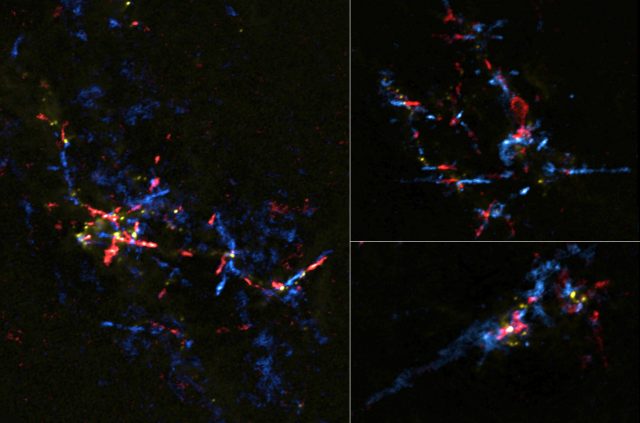Astronomers found a number of stellar eggs containing baby stars around the center of the Milky Way using the Atacama Large Millimeter/submillimeter Array (ALMA). Previous studies had suggested that the environment there is too harsh to form stars. These findings indicate that star formation is more resilient than researchers thought.
Stars form in stellar eggs, cosmic clouds of gas and dust which collapse due to gravity. If something interferes with the gravity driven contraction, star formation will be suppressed. There are many potential sources of interference near the Galactic Center. Strong turbulence can stir up the clouds and prevent them from contracting, or strong magnetic fields can support the gas against self-gravitational collapse. Previous observations indicated that star formation near the Galactic Center is much less efficient.
To investigate the mysteries of the suppressed star formation, a team led by Xing Lu, an astronomer at the National Astronomical Observatory of Japan, used ALMA to observe regions near the Galactic Center which contain ample gas, but no known star formation. Surprisingly, the team discovered more than 800 dense cores of gas and dust.
“The discovery leads to the question of whether they are actually ‘stellar eggs’ or not.” explains Lu. To answer this question, the team again used ALMA to search for energetic gas outflows which are indicative of stars forming in stellar eggs. Thanks to ALMA’s high sensitivity and high spatial resolution, they detected 43 small and faint outflows in the clouds. Lu comments, “our observations prove that even in the strongly disturbed areas around the Galactic Center, baby stars still form.”
The research team is now analyzing ALMA’s higher resolution observation data to better understand the processes driving the gas outflows and star formation near the Galactic Center.
Find your dream job in the space industry. Check our Space Job Board »
More information: Xing Lu et al. ALMA Observations of Massive Clouds in the Central Molecular Zone: Ubiquitous Protostellar Outflows. The Astrophysical Journal (2021). DOI: 10.3847/1538-4357/abde3c
Image: ALMA pseudo-color composite image of the gas outflows from baby stars in the Galactic Center region. Gas moving toward us is shown in blue and gas moving away from us is shown in red.
Credit: ALMA (ESO/NAOJ/NRAO), Lu et al
